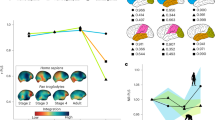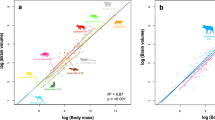Abstract
Three reports on mammalian brain evolution1,2,3 analyse the same comparative data on brain component volumes4 but come to partially conflicting conclusions. Clark et al.3 conclude from their analysis of volumetric brain proportions (“cerebro-types”) that cerebellum size is invariant across mammalian taxonomic groups, the neocortex and cerebellum do not co-vary in size (in contradiction to ref. 1), and cerebrotype-based measures identify directional changes in brain architecture. Here I provide evidence that calls each of these conclusions into question. The failure of the cerebrotype measure to identify species differences in brain architecture that are independent of gross brain size undermines the proposal by Clark et al. that it could be useful for detecting evolutionary patterns and phylogenetic relationships.
This is a preview of subscription content, access via your institution
Access options
Subscribe to this journal
Receive 51 print issues and online access
$199.00 per year
only $3.90 per issue
Buy this article
- Purchase on Springer Link
- Instant access to full article PDF
Prices may be subject to local taxes which are calculated during checkout

Similar content being viewed by others
References
Barton, R. A. & Harvey, P. H. Nature 405, 1055–1058 (2000).
De Winter, W. & Oxnard, C. E. Nature 409, 710–714 (2001).
Clark, D. A., Mitra, P. P. & Wang, S.-H. Nature 411, 189–193 (2001).
Stephan, H., Frahm, H. D. & Baron, G. Folia Primatol. 35, 1–29 (1981).
Putnam, I. K. Proc. R. Acad. Amsterdam 31, 155–168 (1927).
Purvis, A. & Rambaut, A. Comp. Appl. Biosci. 11, 247–251 (1995).
Baron, G., Stephan, H. & Frahm, H. D. Comparative Neurobiology in Chiroptera Vol. 1 (Birkhauser, Basel, 1996).
Finlay, B. L. & Darlington, R. B. Science 268, 1578–1584 (1995).
Author information
Authors and Affiliations
Corresponding author
Rights and permissions
About this article
Cite this article
Barton, R. How did brains evolve?. Nature 415, 134–135 (2002). https://doi.org/10.1038/415134a
Issue Date:
DOI: https://doi.org/10.1038/415134a
Comments
By submitting a comment you agree to abide by our Terms and Community Guidelines. If you find something abusive or that does not comply with our terms or guidelines please flag it as inappropriate.



